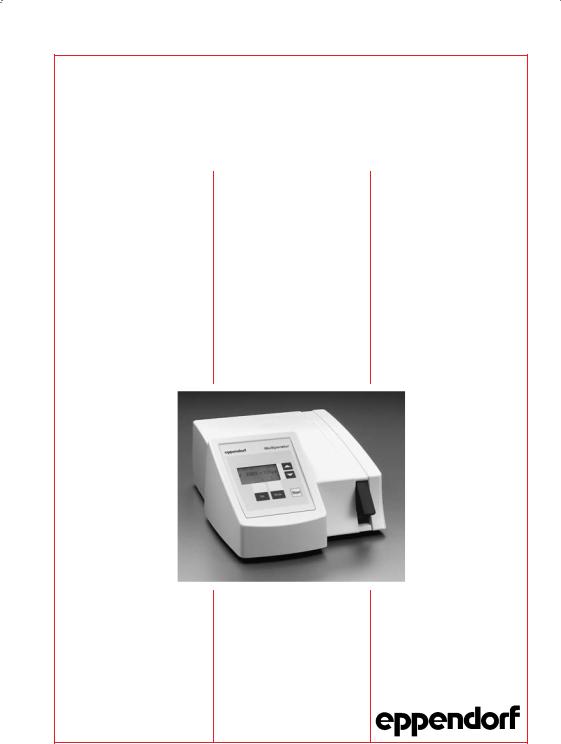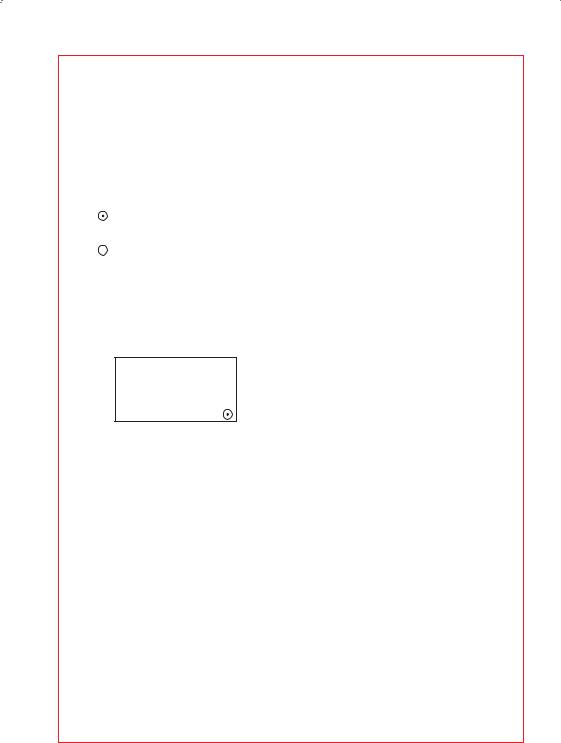Eppendorf Multiporator User Manual

Multiporator
Bedienungsanleitung
Operating Manual Mode d'emploi Istruzioni d'impiego Manual de Instrucciones


Bedienungsanleitung. . . . . . . . . . . . . . . . . . . . . . . . . . . . . . . . . . . . . . . 4
Operating Manual . . . . . . . . . . . . . . . . . . . . . . . . . . . . . . . . . . . . . . . . 46
Mode d’emploi. . . . . . . . . . . . . . . . . . . . . . . . . . . . . . . . . . . . . . . . . . . 89
Istruzioni d'impiego . . . . . . . . . . . . . . . . . . . . . . . . . . . . . . . . . . . . . . 131
Manual de Instrucciones . . . . . . . . . . . . . . . . . . . . . . . . . . . . . . . . . . 172
EG-Konformitätserklärung. . . . . . . . . . . . . . . . . . . . . . . . . . . . . . . . . 213 EC Conformity Declaration
Déclaration de conformité Dichiarazione di conformità CE Declaración de conformidad CEE
Nachdruck und Vervielfältigung – auch auszugsweise – nur mit Genehmigung.
No part of this publication may be reproduced without the prior permission of the copyright owner.
Toute reproduction, complète ou partielle et quel que soit le proèdè est interdiete, sauf autorisation expresse de notre part.
Ristampa e riproduzione – anche di estratti – solo con autorizzazione. Reimpresión y copia – incluso parciales – sólo con autorización.
Copyright© 2006 by Eppendorf AG, Hamburg
B 4308 900.016-10/06063

Contents
1 |
General information. . . . . . . . . . . . . . . . . . . . . . . . . . . . . . . |
47 |
2 |
Area of application. . . . . . . . . . . . . . . . . . . . . . . . . . . . . . . . |
48 |
3 |
Safety precautions. . . . . . . . . . . . . . . . . . . . . . . . . . . . . . . . |
49 |
4 |
Device description. . . . . . . . . . . . . . . . . . . . . . . . . . . . . . . . |
51 |
4.1 |
Delivery package . . . . . . . . . . . . . . . . . . . . . . . . . . . . . . . . . . |
52 |
4.2 |
Startup . . . . . . . . . . . . . . . . . . . . . . . . . . . . . . . . . . . . . . . . . . |
53 |
4.3 |
Cuvette insert. . . . . . . . . . . . . . . . . . . . . . . . . . . . . . . . . . . . . |
53 |
4.4 |
Keypad. . . . . . . . . . . . . . . . . . . . . . . . . . . . . . . . . . . . . . . . . . |
54 |
4.5 |
Keys and key combinations . . . . . . . . . . . . . . . . . . . . . . . . . . |
54 |
4.6 |
Display . . . . . . . . . . . . . . . . . . . . . . . . . . . . . . . . . . . . . . . . . . |
57 |
4.7 |
Electroporation. . . . . . . . . . . . . . . . . . . . . . . . . . . . . . . . . . . . |
58 |
4.7.1 |
Cuvettes and cuvette insert . . . . . . . . . . . . . . . . . . . . . . . . . |
58 |
4.7.2 |
Electroporation buffer for eukaryotic cells . . . . . . . . . . . . . . . |
59 |
4.8 |
Cell fusion (optional) . . . . . . . . . . . . . . . . . . . . . . . . . . . . . . . |
60 |
4.8.1 |
Micro fusion chamber (Electrode gap width 0.2 mm). . . . . . . |
60 |
4.8.2 |
Micro fusion chamber (Electrode gap width 0.5 mm). . . . . . . |
61 |
4.8.3 |
Cleaning the Micro fusion chamber . . . . . . . . . . . . . . . . . . . . |
61 |
4.8.4 |
Helix fusion chamber . . . . . . . . . . . . . . . . . . . . . . . . . . . . . . |
62 |
4.8.5 |
Filling the Helix fusion chamber . . . . . . . . . . . . . . . . . . . . . . |
63 |
4.8.6 |
Fusion and cell suspension extraction . . . . . . . . . . . . . . . . . . |
64 |
4.8.7 |
Cleaning and disinfecting the Helix fusion chamber . . . . . . . |
65 |
4.8.8 |
Electrofusion buffer for eukaryotic cells . . . . . . . . . . . . . . . . . |
65 |
4.9Insert (electroporation / electrofusion) for connecting
external electrodes. . . . . . . . . . . . . . . . . . . . . . . . . . . . . . . . . 66 4.10 Printer connection / printer (optional). . . . . . . . . . . . . . . . . . . 67
5 Mode of operation . . . . . . . . . . . . . . . . . . . . . . . . . . . . . . . . 71 5.1 Mode for electroporation of eukaryotic cells . . . . . . . . . . . . . 71 5.2 Mode for electroporation of bacteria and yeast (optional) . . . 73 5.3 Mode for cell fusion (optional) . . . . . . . . . . . . . . . . . . . . . . . . 75 5.3.1 Function: Cell alignment. . . . . . . . . . . . . . . . . . . . . . . . . . . . . 75 5.3.2 Procedure for cell fusion . . . . . . . . . . . . . . . . . . . . . . . . . . . . 77
6 |
Error messages . . . . . . . . . . . . . . . . . . . . . . . . . . . . . . . . . . |
80 |
7 Maintenance and servicing. . . . . . . . . . . . . . . . . . . . . . . . . 82 7.1 Disinfection . . . . . . . . . . . . . . . . . . . . . . . . . . . . . . . . . . . . . . 82 7.2 Cleaning. . . . . . . . . . . . . . . . . . . . . . . . . . . . . . . . . . . . . . . . . 82
8 |
Technical data . . . . . . . . . . . . . . . . . . . . . . . . . . . . . . . . . . . |
83 |
9 Ordering information. . . . . . . . . . . . . . . . . . . . . . . . . . . . . . 85
9a Ordering information for North America . . . . . . . . . . . . . . 87
46

1 General information
The Multiporator is designed for the electroporation of eukaryotic cells. With the aid of optional modules, it is also possible to perform electroporation on bacteria and yeast as well as fusion of cells. This manual contains information on all possible uses of the Multiporator .
The outstanding feature of the Multiporator is that the parameters entered for the electroporation of eukaryotic cells and for cell fusion are maintained exactly by means of internal calculation of the discharge curve.
47

2 Area of application
Device safety regulations and industrial standards stipulate the following conditions:
–Use the device for experiments in the field of cell technology only
The range of application covers the electroporation of yeast and bacteria and eukaryotic cells as well as cell fusion.
–Please use only original accessories from Eppendorf
Original accessories only may be used. They are designed specifically to ensure optimum functioning of the Multiporator . Additional devices may be used only if recommended by the manufacturer. Eppendorf does not honor any warranty or accept any responsibility for damage resulting from the use of incorrect or non-recommended equipment.
–The device may only be used for research purposes, not for medical and diagnostic applications
48

3 Safety precautions
For reasons of personal safety, it is essential to observe the following!
●Observe the instructions contained in the operating manual
It is essential to comply with the information given in the manual!
●Only use the device with a power supply which has a grounding contact!
●Before starting up the Multiporator , please ensure that the power supply used corresponds to the voltage specifications on the identification plate!
●Do not use the device if it is damaged, especially if the mains cable is damaged.
●The unit may be opened only by authorized service personnel! Before opening the device, switch it off and remove the power supply plug. Potentially lethal voltage inside the unit.
●Do not operate the device in an explosive environment!
●Do not allow any liquid to enter into the Multiporator or the inserts!
●The device should be used for in vitro applications only!
●Use the device only for the purpose for which it is intended.
Do not place parts, devices, tools or other objects into the cuvette insert which have not been recommended by Eppendorf AG. High voltage!
●Use the listed accessories only.
Other accessories may only be used if they are accompanied by a safety certificate from Eppendorf AG confirming their suitability for use!
●Electrical connection to devices which are not mentioned in this operating manual is only permitted with the prior consent of the manufacturer!
●The Helix fusion chamber must be handled with care.
Loose or damaged electrodes adversely affect operating procedures. In such cases, the Helix fusion chamber must not be used!
Do not open the Helix fusion chamber until fusion has finished!
●The Micro fusion chamber must be handled with care.
Take care when filling with cell suspension. Do not touch or move the electrodes with the pipette tip! This may cause damage.
During cell alignment/fusion, avoid direct contact with the electrodes!
49

3Safety precautions
●Cell alignment/fusion may be performed only when the Micro fusion chamber is connected.
The cable is designed for connection to the Micro fusion chamber only. No other connections are permitted! Do not place the plug into liquid!
●The owner or operator of the device is liable for the functioning of the device when the device is serviced or maintained by persons who are not members of the Eppendorf service personnel or when the device is not operated in accordance with the given regulations and precautions. Eppendorf AG accepts no liability for damage resulting from such action. Warranty and liability stipulations which form part of the terms of sale and delivery of Eppendorf AG are not affected by the above-mentioned conditions.
●This operating manual or parts of this operating manual may not be reproduced in any form without the prior written permission of Eppendorf AG!
●Eppendorf AG reserves the right to make technical alterations to this product!
●Transfer
If the device is passed on to someone else, please include the instruction manual.
●Disposal
In case the product is to be disposed of, the relevant legal regulations are to be observed.
●Information on the disposal of electrical and electronic devices in the European Community
The disposal of electrical devices is regulated within the European Community by national regulations based on EU Directive 2002/96/EC on waste electrical and electronic equipment (WEEE).
According to these regulations, any devices supplied after 13.08.05 in the business-to-business sphere, to which this product is assigned, may no longer be disposed of in municipal or domestic waste. They are marked with the following symbol to indicate this.
As disposal regulations within the EU may vary from country to country, please contact your supplier if necessary.
50

4 Device description
The device has four different modification levels: the basic device is used for the electroporation of eukaryotic cells. It can then be developed for the electroporation of bacteria and yeast, with an additional level offering the opportunity to perform cell fusion. These two levels can be combined to form the fourth level.
The Multiporator is operated using an easy-to-follow keypad with display. The insert for the electroporation cuvette is located next to the keypad.
Fig. 1: Multiporator , front view
51

4 Device description
4.1 Delivery package
Basic device: |
Multiporator for the electroporation of eukaryotic |
|
cells; with mains cable |
|
Insert for electroporation cuvettes |
|
Electroporation cuvettes |
|
(Electrode gap width: 2 mm / 4 mm) |
|
Hypoand isoosmolar buffers for electroporation |
|
Operating manual and Basic Applications Manual |
"Bacteria module" optional:
Basic device incl. accessories with integrated bacteria module
Additional electroporation cuvettes (Electrode gap width: 1 mm)
"Cell fusion module" optional:
Basic device incl. accessories with integrated cell fusion module
Helix fusion chamber (Electrode gap width: 0.2 mm)
Insert for Helix fusion chamber
Micro-fusion chamber
(Electrode gap width: 0.2 mm) with special insert Hypoand isoosmolar buffers for cell fusion
"Fusionand bacteria module" optional:
Basic device incl. accessories
with integrated fusionand bacteria module.
52

4 Device description
4.2 Startup
The Multiporator must stand completely on the stable work surface and be safely positioned. There must be enough space that the front and rear ventilation slits are not covered and that air for cooling can reach underneath the device.
Space requirement: Width: 25.2 cm
Depth: 34.2 cm
Height: 12.0 cm
The main power socket with fuse and main power switch is located on the rear of the Multiporator . The mains power must agree with the information on the ID plate. To start the device, insert the power cable into the main power socket and connect it up to the main power supply. Turn on or off the device by pressing the main power switch.
Fig. 2: Multiporator , rear view
Power connection (left)
Printer connection (right)
The delivery carton should be kept in order to be able to safely send back the device in case repairs are necessary.
4.3 Cuvette insert
The insert for the electroporation cuvette is next to the keypad at the front of the device. To remove the cuvette, pull out the cuvette insert. When inserting a new cuvette, ensure that the nose of the cuvette fits into the rear slot. Push the cuvette insert containing the cuvette into the device up to the stop. A sensor in the device detects whether the cuvette insert contains a cuvette.
Note: When transporting the device, please ensure that the insert contains an empty cuvette. Alternatively, transport the cuvette insert separately.
Different inserts are used for the modification level "cell fusion".
53

4 Device description
4.4 Keypad
The keypad is used to enter the electroporation or the electrofusion modes, to select the parameters and to start the application. Depending on the modification level, 1 to 3 modes can be selected. Key combinations can be used to set the date and time as well as the volume of the acoustic signal.
Fig. 3: Control panel with keys and display
4.5 Keys and key combinations
SET
The SET key is used to select the desired parameter. This parameter is underlined in the display. Further parameters are selected by pressing the SET key an appropriate number of times. A SET sequence is ended either by pressing the SET key repeatedly until the underlining disappears or by pressing the MODE or START key. (Note: The MODE key switches to another mode if available.) Parameters are modified using the up/down arrow keys. When the lowest possible value has been reached, the display then moves to the highest value. Similarly, when the highest value has been reached, the display then moves to the lowest value.
54

4 Device description
MODE
The MODE key is used to activate the mode with which electroporation or electrofusion is to be performed. It is only possible to select modes in accordance with the modification level of the device. This means for the basic device, the mode for the electroporation of eukaryotic cells is available, while there is a choice of three modes for the maximum expansion level.
The corresponding symbol then appears in the display:
: Mode for eukaryotic cells Modification level: Basic device Pulse used: Decaying e-function
: Mode for bacteria and yeasts Modification level: Bacteria module Pulse used: Decaying e-function

 : Mode for cell fusion
: Mode for cell fusion
Modification level: Fusion module Pulse used: Square-wave pulse
START
The process required is started by pressing the START key.
Arrow keys
The arrow keys are used to modify the selected (i.e. underlined) parameters in the desired direction.
55

4 Device description
Setting the date
The procedure for setting the date and time can be activated by pressing the SET and MODE keys simultaneously. If the SET key is pressed again, the underlining in the display for the date and time moves from left to right. The arrow keys can thus be used to modify the settings.
To end the process for setting the date, press the SET key repeatedly until the underlining is no longer visible in the display. Alternatively, the underlining disappears from the display when the MODE or START key is pressed. (Note: The MODE key switches to another mode if available.)
Setting the volume of the acoustic signals
The procedure for setting the volume of the acoustic signals can be activated by pressing the MODE and START keys simultaneously. "VOLUME" then appears in the bottom line of the display, together with a figure in percent. This figure indicates the volume and the tone type and can be modified using the arrow keys.
To end the procedure for setting the volume of the acoustic signals, press the SET, MODE or START key. (Note: The MODE key switches to another mode if available.) "VOLUME" then disappears from the display.
Reset
An experiment can be terminated only by pressing the main power switch. This switch also functions as a reset switch.
56

4 Device description
4.6 Display
The date and time of day are always displayed in the uppermost line of the display. The parameters which are relevant for the experiment appear in lines 2 to 4 in larger letters and in bold print. The parameters and the number of parameters differ according to the mode which has been selected. The mode which has been selected is always represented by a symbol on the right of the bottom line:
: Mode for eukaryotic cells Modification level: Basic device
: Mode for bacteria and yeasts Modification level: Bacteria module

 : Mode for cell fusion
: Mode for cell fusion
Modification level: Fusion module
"VOLUME" or the remaining time for the experiment can also appear in the display in this line.
12.AUG.00 13:37
U 500V τ 220µs
Example of the display for setting
n1 the volume of the acoustic signal
VOLUME 100%
During and after the experiment, the display changes to show the information relevant to the stage of the experiment which has been reached.
57
